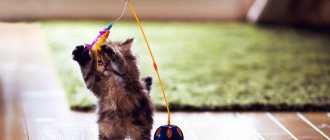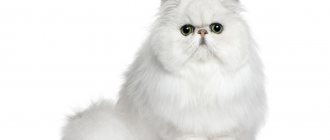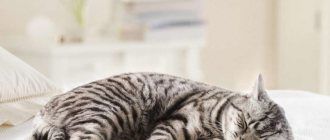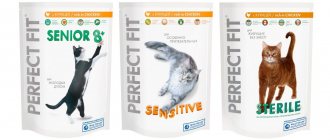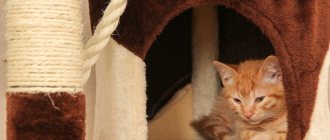When overlays are needed
Anti-scratch caps (second name) are oblong caps made of soft plastic or silicone. They follow the shape of the claw and are “settled” on top using special medical glue. It is hypoallergenic and suitable for most cats without causing any discomfort.
Although not all owners and veterinarians support the idea of wearing such attachments, there are several reasons when it is still worth purchasing them and teaching your pet to walk in them.
- Small children.
Kids love to play with cats, cuddle, pull by the tail, pinch and show love in other “non-standard” ways. Not all animals are able to tolerate bullying and react calmly to it. Some may use their claws as a defense and inadvertently injure the child's skin. In such cases, anti-scratches will be one hundred percent justified. - Protection of household items.
Not only sofa upholstery, wallpaper and door frames, but also curtains, carpets, children's toys, and clothes often suffer from tenacious cat claws. To protect interior and wardrobe items from damage (often irreversible), you will have to use overlays.
- Character traits.
It happens that cats cannot be re-educated or show aggression towards their owners, guests, children, etc. They can rush at imaginary offenders, scratch themselves, break free from their hands - behave nervously and inappropriately. Or hurt other domestic animals present on their territory. The use of caps will reduce the risk of injury and slightly pacify the cat's temper. - Household safety.
Here we are talking about possible harm to health. The claws contain microbes, and if there are deep scratches, they can enter the wound, causing inflammation. In the worst case, blood poisoning. People who have weak immunity, poor blood clotting, or a predisposition to various allergic reactions should beware of damage.
Pros and cons of anti-scratch
Perhaps the most important advantage of this simple device is the integrity of the apartment; it is the unshakable desire of cats to sharpen their claws on furniture or wallpaper that forces owners to look for ways to solve the problem; surgical intervention is not an option, and beloved pets often remain indifferent to scratching posts. Also an undoubted advantage is safety for others, especially if the cat has a bad character and there are small children in the house. Soft caps are absolutely safe; they are glued to a special medical glue, which is used in cosmetology and surgery. In addition, they do not interfere with bone growth. Some owners perceive them as a fashionable cat accessory and match them to the color of the collar; it looks very elegant.
Disadvantages include individual intolerance. Some temperamental cats do not want to get used to the new product and try in every possible way to get rid of it. Anti-scratch products are contraindicated for pets that have access to the outdoors. The caps do not give them the opportunity to cling to a tree, calmly walk along a fence, or extend their claws for protection, which is fraught with serious injuries, and it becomes impossible to hunt with them. Manufacturers of anti-scratch products assure that there are no side effects, only in rare cases they can provoke deformation of the nail plate or inflammation, but this only happens when the claw is skillfully trimmed or the cap is applied incorrectly.
Selection rules
There are many models of anti-scratch pads on the market, not only in different colors, but also in size categories. Conventionally, they are all divided into the following groups:
- XS (supermini)
- for kittens from 6 months. - S (mini)
- weight 2-4 kg. - M (medium)
- weight 4-7 kg. - L (large)
- weight 8 kg or more.
As for the price, the average cost of a set (40 pieces + glue + instructions) costs between 300-700 rubles. You can buy it at a pet store, veterinary clinic or specialized online markets.
How to put on caps
Without skill for the first time, it is better for the owner to enlist the help of someone from the family. Stock up on treats and patience. It is even possible to turn to professionals to spy on the progress of the process in their execution.
Subsequently, with some experience, fitting caps on claws will become the same routine procedure as combing.
Sizing
The diversity of breeds, sexual dimorphism, and differences in weight for cats of different ages certainly influenced the production of caps. Nozzles are available in four size groups, namely:
- for very small kittens or breeds of miniature cats with a light weight of up to 1.5 kg, anti-scratch pads marked XS are made;
- the next weight category from 1.5 to 4 kg assumes size S;
- for larger cats that weigh between 4-6 kg, it is necessary to select attachments marked M;
- Very large cats that weigh more than 6 kg will most likely need to purchase caps of size L, they are designed specifically for such indicators.
Fitting
Before you start manicuring, your cat needs to try on a couple of caps on claws of different lengths. To do this, they take her in her arms, calm her down and lightly press her fingers on the pad so that she involuntarily releases her claw.
Before trying on, it is recommended to slightly trim the claws - 2-3 mm will be enough. In this case, it is advisable not to leave sharp edges on the claw and polish it a little.
The cap is put on from above and ensure that it fits tightly and does not reach the sinus of the claw by 2-3 mm. This will prevent injury and foreign body ingrowth into the bed. If the nozzle is much longer than required, then it is cut to the required size from the socket side and only then the sticking procedure begins.
Sequencing
To glue the treasured anti-scratches yourself, be patient. You may have to do this in several passes, but with experience the procedure will not cause any trouble. The sequence for each claw is the same: to begin with, they are simply trimmed and polished, and treated with an antiseptic. There should be no dirt left on the claws, and then start applying the sticker.
Of course, to do this you need to choose a moment when the cat is in the mood to be held and cuddled. The caps, previously adjusted to size, and glue are laid out nearby.
The cat is carefully fixed on his lap, making sure that this is not stressful for her: either they calm him down with a voice, or they stroke him and scratch him behind the ear. Then everything is simple, and if you get the hang of it, it’s fast:
- squeeze a little glue into the cap so that it fills no more than 1/3 of the internal cavity;
- take the cat’s paw in your hand and gently press on the sinus;
- when the claw reaches its full length, carefully place the cap on it to the end and squeeze it on the sides;
- after all the planned anti-scratch pads have been glued, the cat is held in your arms for another ten to fifteen minutes until the glue sets.
Of course, first you can isolate the claws sequentially on each paw with a short break so that the cat can rest from obsessive attention and get its nerves in order. Then - with experience, on all paws at once.
In any case, you need to be prepared that the cat will try to get rid of the innovation. There is no need to worry: even if she manages to remove the nozzle with her teeth, she does not pose any danger. True, provided that the caps were purchased of high quality and certified for use.
When pads are not needed
It is not always necessary to use silicone attachments for cats. In some cases, they may be simply useless or even harm the animal. Anti-scratch guards cannot be worn by:
- Kittens.
The nail plate is formed until about six months, so it is recommended not to do anything with the claws during this period of time. It's best to focus on teaching kittens how to use a scratching post. - Elderly cats.
The older the age, the less active the animals become. They stop frolicking, running around the apartment, tearing up furniture and doing other dirty tricks. Therefore, there is no point in once again exposing their nervous system to stress and tormenting them with a new procedure. - Sick cats.
If for some reason the pet feels unwell or is in the acute phase of the disease, then it is advisable to wait until the pet has fully recovered from the “manicure”. This also applies to cases where there are some dermatological problems with the paws. - Street cats.
Unlike their domestic counterparts, who do not need to constantly keep their instinct of self-preservation in good shape, climb trees and get food on their own, wild animals with overlays simply will not survive. Their claws serve as a tool for protection and coordination.
At what age can cats have anti-scratch pads?
There are no age-related contraindications for gluing soft claws.
But, before you buy a pack of bright multi-colored protective caps for your pet, you need to decide whether she really needs it.
Veterinarians do not recommend gluing pads in the following cases:
- small kittens up to 6 months. Their claws are still very tender and soft, they grind down on their own during play;
You can read about how to determine the age of a kitten here:
- elderly cats who, due to age, have lost interest in wallpaper and furniture and no longer scratch anything;
- street cats – this will be discussed below.
Before gluing the anti-scratch pads, the cat needs to trim its claws , this will allow the soft claws to be fastened efficiently and tightly.
Claws are trimmed with special clippers
Advice! Each package with pads contains glue and detailed instructions, which describe step by step how to apply anti-scratch pads to a cat. If difficulties arise, for example, you have an easily excitable or aggressive animal, it is better to contact a specialist.
The cap should fit snugly on the claw
Useful tips
To make it comfortable for your cat to wear the caps, veterinarians advise adhering to a number of requirements:
- Before the procedure, it is necessary to trim the claws approximately 1 mm from the edge. So as not to touch the blood vessels and cause pain to the animal. On the cut edges, the linings fit more tightly and, accordingly, fall off less often.
- Do not neglect the size chart and select a set based on the dimensions of the cat. The cap should not touch the skin, but should completely cover the nail. If there is an error with the size and it is not possible to exchange the pads, then they can be carefully trimmed at the base.
- Typically, anti-scratch guards are only applied to the claws of the front paws, since the cat does not sharpen the hind paws. She gnaws them on her own without the involvement of external “helpers.” Moreover, it is not necessary to cover all five claws; the side one can be excluded - it is not often used in life, plus, it does not peel off in time. As an experiment, you can try first sticking a cap on it and then leaving it free.
- Silicone disappears as the upper stratum corneum of the nail grows. Natural “reset” occurs approximately every 2 months, so there is no need to specially peel off the pads. On the contrary, they may fall off on their own if they were chosen in the wrong size, or if the cat deliberately chewed them off with his teeth.
Regularly checking your cat's paws can prevent many problems. For example, inflammation due to improper use of anti-scratch products or allergies if the skin reacts to silicone or glue.
What are silicone anti-scratch pads for?
The point of anti-scratch for cats is to protect the owner's property: it is doubtful that anyone will like the torn furniture. Everything that the pet previously diligently tried to tear with its claws will remain intact: the cat will no longer spoil the wallpaper, door frames, tablecloths, sofas, armchairs, carpets. In a word, all things in the house will remain intact.
Those who especially often suffered from sharp cat claws can breathe easy: there will be no scratches on their hands, which serve as open gates for any infection, and a particularly zealous cat will not be able to damage children’s eyes. Cultured cat paws will protect the health of the whole family.
For people whose health is compromised, who have allergies, poor blood clotting or immunodeficiency syndrome, any scratch is dangerous. And funny silicone caps will prevent harm to the health of such a person.
So, what are the benefits of soft claws for cats :
- peace of mind for all family members: you can play with the cat without expecting a clawed trick from her;
- calmness of the pet: there are no consequences from claws - there is no reason for the owner to be angry;
- maintaining the health of all household members;
- apartment furnishings unspoiled by claws.
Thanks to Toby Wexler for his useful invention!
Are anti-scratch products harmful to cats?
global $ads_google;
//data-ad-slot=”2475549904″ $ads_google = empty($ads_google) ? false : true; ?> if ($ads_google == false) {?> $ads_google = true; ?> } ?> First, any cat will try to chew and remove the unusual covering in any way. Then a worm of doubt immediately begins to gnaw at the caring owner - is the pet suffering from such a manicure?
According to information from manufacturers, silicone tips are a completely safe material. Even if the cat accidentally swallows the anti-scratch, it will come out naturally. The only exception may be if your pet is allergic to glue, which itself is not toxic.
However, there are various myths floating around such an interesting colorful device. To dispel all doubts, let's consider all the disadvantages of a rubber cat manicure:
- noisy movement around the house - the sound with which an animal moves is impossible not to hear. The sound of a cat trying to grind off its claws is not very pleasant. As a solution, it is proposed to wear anti-scratch pads only on the front paws;
- fragility of the caps. A nimble and active cat will wear out the product in a month. There are zealous creatures that manage to remove the caps in the first couple of days. In this case, replaceable nozzles should be ready;
- takes a long time to get used to - the cat will be unfamiliar with such an innovation, and walking at first will be uncomfortable.
If you listen to reviews about rubber covers for claws, then besides the fact that the cat needs to get used to them, there is nothing negative.
How to glue overlays: instructions
The procedure involves not only mechanical actions, but also a corresponding psychological component. Do not forget that for an animal any manifestation of violence against its freedom is a great stress.
- Sit the cat on your lap, stroke it, talk in a calm voice, affectionately, without pressure.
- Take one paw and press on the pad until the nail appears. Try on the cap to see if it fits properly. If necessary, cut to the required length on the side of the hole through which it is inserted.
- Treat the inside of the lining with the glue from the kit. The silicone surface should be covered no more than 1/3.
- Put on the nozzle using a sliding motion, press on both sides for about 3-5 seconds until the glue sets.
- After 10 minutes, check how well the anti-scratches are fixed and, if necessary, make corrections.
- Praise the cat for its patience and treat it with a tasty treat.
Anti-scratch for cats: Reviews from veterinarians about the benefits and harms of soft claws
Reviews from veterinarians about anti-scratch products for cats are very contradictory.
Some consider soft claws a humane and safe way to solve the problem of scratches on furniture and on the body, others consider them an outrage against the natural instincts of the animal, and others consider them simply a glamorous decoration.
Let's try to figure out this seemingly simple question together.
Feedback from veterinarians regarding anti-scratch products for cats upsets many lovers of these affectionate animals.
On the one hand, thanks to silicone pads, the cat’s habit of sharpening its claws ceases to poison the joy of communicating with a four-legged family member.
On the other hand, all this talk about inhumane treatment of pets raises certain doubts and adds a fly in the ointment.
What people don’t come up with so that the cat’s instincts are realized and the domestic idyll is not disturbed.
Some make scratching posts with their own hands, others buy ready-made options built into the cat’s house, and others buy multi-colored anti-scratch pads.
If you want to make a cat house with your own hands, we recommend reading the article https://kot-pes.com/domik-dlya-koshki-svoimi-rukami/
This is what silicone pads for cat claws look like
Basic questions when purchasing
When faced with the choice of whether to buy such devices for your pets or get by with the classic “sharpening” of claws/surgery, a number of related questions arise. For example:
- What happens if an animal swallows the bait? Nothing bad will happen. The caps are made of non-toxic material, have a smooth surface and, when ingested, can easily pass through the entire gastrointestinal tract and exit naturally.
- How quickly will the cat get used to the new condition? Everything is individual. Usually the adaptation process lasts 2-5 days, during which she may get nervous and try to chew or remove the interfering accessory, but then she gets used to it and resigns herself.
- Will the habit of sharpening your claws go away? No, the instinct remains, the animal will still release its claws, but it simply will not be able to harm furniture, walls, wallpaper or a person.
- Which manufacturer is better? The best brands that have proven themselves in this area are: Soft Paws Nail Caps For Cats (USA), Cliny, Crazy Liberty (Russia), Barbos (Russia).
Veterinarian's opinion
Veterinarians are not so optimistic about anti-scratch products.
In any case, even in an animal with a balanced character, the procedure of gluing the caps is stressful.
It can last from several days (adaptation period) to several weeks.
Important! A cat must sharpen its claws - this is what nature intended. One can only guess how the prohibition of instinct is reflected in her psyche. The cat does not adapt to its new sensations - it simply resigns itself.
It is no longer possible to scratch furniture. How to have fun now?
After gluing the protective caps, the cat experiences tactile discomfort for a long time.
Now the animal cannot jump high or fully feel the surface on which it moves with its paws.
As for street cats - those that live in the house and have the opportunity to walk freely on the street - anti-scratch treatments are strictly contraindicated for them!
Imagine that an animal needs to quickly run away from a dog and climb a tree.
How can it, having caught its claws in the bark, do this deftly and quickly?
How can he defend himself and protect himself with a blow from a paw that has absolutely smooth caps instead of claws?
Some cat owners undergo declawing surgery for their pets.
If you choose between removal and anti-scratch, silicone caps are much less likely to injure animals.
Claw pads or anti-scratch pads for cats
It is known that their inventor was Toby Wexler, a US veterinarian who (like most of his colleagues around the world) was horrified by onychectomy more than 15 years ago. Let us remind you that the operation involves amputation of the claws along with the last phalanx of the cat's fingers.
By the way, in our time, thanks to the European Convention protecting animal rights, onychectomy (fraught with a bunch of postoperative complications) is prohibited in most European countries. Russia is not included in this list.
Wexler's invention is designed to protect the owner's skin, furniture and walls from being torn by sharp claws, while maintaining the health of the animal.
Appearance
This simple device is a cap (rubber, silicone or polypropylene) that follows the outline of a cat's claw. To keep the cap firmly, its inner surface is coated with glue, which is sold in the kit. One set of “soft claws” (20 pieces) is usually enough for 1.5-2 months.
Anti-scratch pads are available in 4 sizes, always indicated on the packaging. The main difficulty is not to miss the size, which has to be determined by eye.
Dimensions:
- XS – for kittens up to six months old, weighing 0.5–2 kg;
- S – for cats weighing 2-4 kg;
- M – for cats weighing 4-6 kg;
- L – for large cats (including Maine Coons), weighing over 6 kg.
To please the owner's cat, the caps come in all the colors of the rainbow, including orange, blue, red, pink, purple and yellow. For those who do not like to stand out, black and natural (transparent) shades are available. There are many polychrome options.
The effect of caps on nail growth
No negative effect on the regrowth of horny appendages (claws) was observed when using anti-scratch pads. When the pads are properly fixed, the claws grow normally.
How they are fixed on a cat's claws
Only an extremely phlegmatic cat will tolerate the manipulation of gluing anti-scratch pads without objection, especially if you are going to do this for the first time. A few days before the intended procedure, begin to stretch your pet’s paws (5 minutes a day), gradually teaching him to remain calm during the massage.
As soon as the animal stops tearing out of your hands when you touch its paws, proceed to the “Soft Claws” operation, not forgetting about the preparatory measures:
- trim the claws by 1-2 mm (with a trimmer or scissors) so that the pads last longer;
- the pads must be tried on in advance to ensure the correct size;
- if necessary, cut the caps themselves (if you didn’t get the size right);
- lightly walk over the surface of the claws with a nail file (for better adhesion with glue);
- Before gluing, wipe the claw with any product (without acetone) to remove dirt.
Important! It is customary to wear pads only on the front paws, since the cat usually uses them to target furniture, an enemy, or wallpaper. If the animal is particularly aggressive, the caps are also placed on the hind legs.
Your actions when gluing anti-scratch pads:
- Take the cat in your arms, pet him and calm him down.
- Squeeze the glue inside about 1/3 of the cap.
- Start massaging the paw and press on the pad to release the claw.
- Put the cap on with a sliding motion and, fixing it, lightly press it from the sides for 5 seconds.
- Pet the cat, talk to him, give him his favorite treat and do not let him go for 5-10 minutes so that the anti-scratch pads are completely fixed.
Fingers stained with glue are cleaned with nail polish remover or acetone.
The cat does not always like the new manicure, and she actively chews artificial claws. As a rule, it takes 2-3 days to get used to the pads.
At what age can you glue?
“Soft Claws” have no age restrictions. It is assumed that the cat owner will use common sense, which will suggest at least two age categories as exceptions.
Growing animals up to six months do not need claw pads: their horny appendages are soft and wear off perfectly when running and playing. Older cats who have stopped sharpening their claws on the owner’s furniture do not need anti-scratch protection either.
